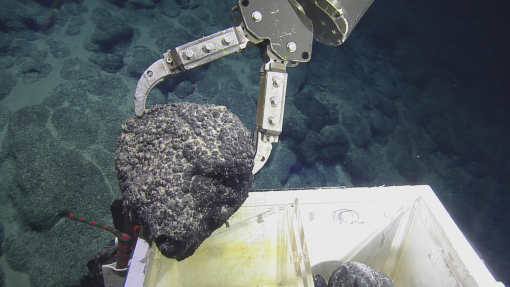Collecting and Analyzing Deep Sea Volcanic Rocks

Expedition NA141 has taken the team to Johnston Atoll, exploring ancient volcanoes from the Central Pacific. Throughout the expedition, the watch teams are on the lookout for angular-looking basalt rocks along the slopes. The team hopes these rocks will contain the clues to reveal exactly how old these seascapes are and how they formed across the region. Back on shore after the expedition, rock samples will have a variety of analyses conducted on them. For all expeditions onboard the E/V Nautilus, geologic specimens are curated at the University of Rhode Island Marine Geologic Samples Laboratory (MGSL) and made available for request by the science community.
Current models estimate that the seamounts and volcanoes found around Johnston Atoll are between 80 -100 million years old. This means these eruptions' contemporaries were the classic Cretaceous dinosaurs like Tyrannosaurus rex and velociraptors. Lab analysis is needed to determine a more exact age, which will also help geologists understand how Johnston Atoll seamounts sit in the geological history of the Central Pacific.
Videos of the seafloor scenes revealed in ROV Hercules' lights alone canʻt answer many of our team's geologic questions, which is why we need to collect rocks. These seamounts have steadily accumulated exterior rock coatings known as ferromanganese crusts for millions of years. The crusts, layered like sugar on a jawbreaker, are made of minerals precipitated from the seawater, coating the basalt and hiding aging information.

After ROV Hercules brings the collected rocks back to E/V Nautilus, the science team will assign each one a specific sample number. They record preliminary observations, including rock type (ie: basalt, palagonite, hyaloclastite) and the degree of mineralization and alteration. Next is the fun part: the rock samples are cut in half with the onboard rock saw, giving researchers their first idea of whether or not the sample is appropriate for age determination subsampling.
"Cutting the rocks open on board is exciting since each rock is wrapped in FeMn, making the experience like opening birthday gifts," says Brandon Scott, who will analyze these rocks as part of his graduate work.
There are many different types of rock analysis from visual measurements of thin petrographic slices (~30 um thickness) to detailed isotopic composition evaluations. The rocks from the NA141 expedition will be ground into a powder and analyzed using x-ray fluorescence (XRF) and inductively coupled mass spectrometry to obtain the concentrations of most elements within the rock. These elements' ratios and relative concentrations can infer the mantle source reservoirs that source the lava and the depth and degree of mantle melting. The primary analytical goal is to determine the age of the seamount lava flows.
This technique is known as Argon-Argon geochronology or 40Ar/39Ar. Based on the pattern observed in lava that as it ages, argon (a noble gas) is lost upon eruption. At the same time, the radioactive parent (potassium) is retained. Therefore, once the lava crystallizes, all the daughter isotope (40Ar) that is produced can be measured to determine how long the lava has existed since crystalizing. The samples from this expedition will be analyzed within the Nevada Isotope Geochronology Laboratory at the University of Nevada, Las Vegas.
When exposed to seawater for tens of millions of years, basalts undergo a chemical reaction called secondary reaction in which their harder minerals react with salt-forming a soft clay-like center inside the ferromanganese crusts. For the 40Ar/39Ar age determination method to work, we need rocks that retain their original crystalline character. There is no way of looking through the ROV cameras to know if the center of a rock retains its original hard rock center or has been remineralized to clay.

This region of the Pacific contains numerous seamount chains that potentially formed from the Pacific crust moving over stationary melt sources known as hotspots. We can reconstruct how the Pacific plate has moved through time by determining the formation age of these seamounts. Particularly of interest are the seamounts in this region that bracketed a global-wide plate reorganization event sometime around 100 million years ago. By determining the age of the seamount chains that show a change in orientation, we can define the timing of this event on the Pacific Plate, which will provide insights into what caused the global plate reorganization event.
This expedition is funded by NOAA Ocean Exploration via the Ocean Exploration Cooperative Institute.

Deep Sea Biodiversity & Ancient Volcanoes near Johnston Atoll
Johnston Atoll, one of the most isolated atolls in the world, is located in the central Pacific Ocean, between the Hawaiian Islands, the Line Islands, and the nation of Kiribati. Around this atoll, the Pacific Remote Island Marine National Monument (PRIMNM) was expanded in 2014 to protect the full 200 nautical mile perimeter of the exclusive economic zone (EEZ) encompassing many unexplored seafloor features.



